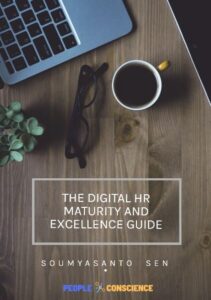Data driven recruitment has a significant, positive impact on talent management strategies and business performance. As technology becomes more sophisticated, AI is playing an increasingly essential role in decisions made around hiring and is used by brands such as Facebook as an integral part of the screening and assessment of candidates.
This article written by Kate Smedley, examines its ongoing effect on the jobs market and the ways in which HR can harness its advantages to better understand, improve and predict hiring needs and potential problems.

Changing employment sectors
AI is broadly defined as ‘machines which perform tasks which humans are capable of performing’. It has been traditionally been regarded as a threat to jobs, with the most drastic predictions suggesting that unemployment rates will reach 50% within 30 years, but perceptions and predictions are changing.
Rather than AI leading to a jobless future, the 2016 report from Stanford University’s One Hundred Year Study on Artificial Intelligence suggests that AI will be regarded as a ‘radically different mechanism for wealth creation’ replacing ‘tasks rather than jobs’ and leading to the creation of new types of jobs.
To give this some context, a reported 60% of existing retail jobs have a ‘high chance’ of automation by 2036 but a new sector of e-commerce has emerged in response to this change. As predicted by Deloitte, high risk jobs are being replaced by more creative low risk jobs with each new job paying a salary £10,000 higher than the one it replaced, in the process adding £140 billion to the UK economy. This shift is also apparent in the rising demand for specialist tech skills in areas like data analysis across all sectors.
Stanford University’s 2016 report also concludes that the impact of AI isn’t limited to medium skilled jobs but will invade ‘almost all employment sectors’ affecting the higher end of the job spectrum, encroaching on professional services and impacting even cognitive roles.
The need for the human touch
The proliferation of AI is not without its problems, however. AI-averse HR leaders have enjoyed some justification for their reluctance to engage with technology in recent months. To add to the negative publicity generated by Microsoft’s Twitter bot, Tay, Facebook has faced criticism after replacing its ‘trending’ team with algorithms, which led to the publication of false and inappropriate links. More relevant to HR was LinkedIn being forced to denyclaims of gender bias in its search algorithm.
AI is most effective when combined with the human touch. It is based on mathematics; when harnessed within HR technology, it improves the hiring process, from candidate screening to onboarding, enabling HR to create more effective talent management strategies. AI is a collaborative robot or ‘co-bot’ as it is referred to, freeing people to carry out more productive tasks.
Technology and the competitive advantage
Technology is vital to the future of the workforce, giving employers a competitive edge. A study from Oxford Economics, entitled Leaders 2020, found that the most successful businesses are one and a half times more likely to use technology. It also reiterates the following:
- The businesses it describes as ‘digital winners’ have strong talent acquisition strategies and provide updated technology to their employees.
- These organisations also tend to have happier and more engaged employees.
Of concern was the fact that less than half of respondents stated that their company leadership was ‘highly proficient’ in using technology, a growing problem in the UK’s economy.
Incorporating AI into the recruitment process
AI should be regarded as critical to all businesses. It guides HR to make better decisions, ‘replacing tasks rather than jobs’ and driving improvements across the following areas:
- Improving talent acquisition : Your business will be better informed and able to predict future hiring needs, source people more quickly and identify skills gaps within your existing workforce. HR technology is the first step towards identifying those gaps.
- AI, in the form of HR analytics, helps to improve diversity and reduce bias in recruitment. Diversity means hiring the best candidate for a position who will also fit well with your existing team. The Oxford Economics report found that a diverse workforce results in higher revenue and profitability.
- HR analytics provides insight into the historical success of your hiring process, enabling HR to eliminate poor hiring decisions, cutting out the need for ‘gut feel’ and guess work. It also predicts the candidates most likely to succeed.
- Improving retention : AI can quickly identify factors affecting high staff turnover. For example, your current pay scale may match the market but if it veers towards the lower end, your business risks losing talent to your competitors. HR analytics enables identification of those patterns within your organisation.
- HR analytics predicts the skills needed for your future workforce, equipping HR with vital data needed for effective planning. In a knowledge based economy, the World Economic Forum predicts that a combination of mathematical and interpersonal skills will be among those in highest demand. Traditional educational models coupled with a lack of vital skills in the UK are leading to a mismatch of talent, however. To be truly effective, a ‘joined-up’ HCM process begins with a recruitment management system that integrates ongoing employee skills assessment and training.
- Drives hiring based on talent : Facebook recently revealed one of the central components to its hiring strategy, namely Marcus Buckingham’s and Curt Coffman’s book “First, Break All the Rules.”, first published in 1999. It recommends that the primary focus in candidate selection is on talent, which they describe as a ‘recurring pattern of thought, feeling or behaviour that can be productively applied’. Technology provides a range of techniques from sophisticated screening through applicant tracking software and online assessments to virtual reality such as video interviews enabling HR to identify, focus on and hire talent.
Advorto’s recruitment software provides workflow and structure across the entire hiring process, offering a dynamic database of candidates and analytics. Used by some of the world’s leading organisations, it provides a straightforward first step into AI, HR analytics and big data.
Start your 30 day free trial today.
This article has been originally published in Advorto and content is share by The HR Tech Weekly® blog.


